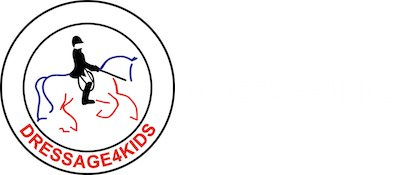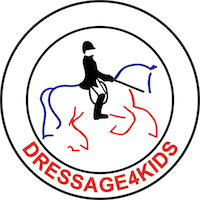D4K Video Tips
Dressage4Kids – Tips for Good Video
1. Instructions. If you need video to complete an application, make sure you read the instructions first. What are the evaluators requesting?
a) Do they want a continuous shot (no editing), or is editing acceptable (choosing shorter clips and splicing them together)?
b) Are there specific movements you are required to show (such as leg-yield)?
c) Is there a specific order of gaits or movements (for example, walk then trot then canter) or can you choose the order of gaits and movements? If you can choose the order, showcase your horse’s best movements first and also make sure you end on a good note. First and last impressions matter.
d) Is there a specific point of view requested, for example video from “C” or video from the side (E/B)? Can you stand in the center of the arena so you are closer to all the points of the arena (as opposed to standing at one end of the arena where one end is close and the other end is far away)?
e) Do the evaluators want sound? No sound? Do they want to hear your instructor coaching you? Is there a noisy leaf blower in the background?
f) Familiarize yourself with the instructions, and maybe even consider creating your own pattern or “script” (make sure it’s within the time limit) – practice it and make sure it’s smooth before you commit to videoing it.
2. Equipment. Choose and prepare your equipment.
a) Do you have access to a high quality video camera? Are you going to be shooting with an iPhone? Check your video settings and, if you can, set them at a higher quality (google video camera settings). For example, 4k at 60 fps (frames-per-second) will record in higher quality than 720p at 30 fps.
b) Check your storage space – do you have enough storage to take a 4-5 minute video or are you going to run out of storage part of the way through? Keep in mind, higher quality recordings take up more storage space.
c) Do you have access to a tripod (to prevent camera shake)? If you don’t have access to a tripod, can you DIY one? Is there a fence post you can use or a couple cavaletti blocks you can stack to simulate a tripod? Or do you have a friend with a steadier arm than you who could video on your behalf?
d) Practice keeping the horse and rider in the center of picture and filling approximately 70% of the frame with the horse and rider - this may require panning and zooming in and out. Try to keep the zoom smooth (not zooming in and out too quickly or abruptly) and avoid zooming in and out too much (this has a tendency to make the viewer feel car sick). If you can, stand in a place where zoom won’t be required. Practice keeping the horse and rider within the frame while keeping the camera steady.
e) Do you know how to use the focus function on your device? Make sure the horse and rider are in focus.
f) Shoot horizontal (like landscape, not vertical, like portrait), unless the instructions tell you otherwise.
g) Make sure you keep your camera level (you don’t want the horse and rider looking like they’re climbing a mountain or falling into a ditch).
h) Review the sound requirements (see #1 above regarding reading instructions) and consider changing your equipment settings to mute to avoid recording sound with the video.
3. Background. Check the background – is one end of the arena being excavated? Is there a carnival in the background? As much as possible, make sure your area is free of potential distractions (for your horse and for the viewer).
4. Lighting. Check the lighting – keep the sun at your back. If part of the arena is in full sun and part in shadow, consider limiting your video to one part of the arena so your camera doesn’t have to try to shift focus, exposure, and white balance back-and-forth. The more uniform the lighting, the easier for your camera. Also make sure there is enough light – for example, do not try to shoot in an arena with no arena lights after sunset. If you can, video short clips for practice and look at the replays – then decide where best to stand based on the lighting, background, etc.
6. Practice. Consider practicing videoing. Is your horse going to be spooky with a new piece of equipment in the ring? Do you tense up when you’re on camera? Consider practicing with video conditions so you, your horse, and your videographer all become comfortable.
7. Presentation. Prepare your look – pretend you are going to a horse show. You and your horse (and all your tack and equipment), should be clean (give your horse a bath beforehand), neat, tidy, and well-turned out. Boots should be clean and polished, hair neatly secured, shirts tucked in. Make sure the tack you are using is consistent with USEF tack and equipment rules. Check the video requirements – does your horse need to be braided? Even if not, consider braiding (if your braids are good) to show off your horse’s beauty. Pay attention to details.
8. Soundness. Is your horse sound? Unless you are specifically shooting video for your vet because your horse did something silly in turn-out that day, make sure your horse is sound before you video.
9. Review. Remember your objectives. After you video, make sure to watch the replay and re-read the original instructions. Does the video fulfill the requirements?
10. Submit. Your video is now ready for submission.
a) make sure you upload the video according to the instructions – does it need to be uploaded to YouTube? Can you send it as an email attachment or via WhatsApp? If you have any questions about how to submit the video, it’s always best to ask the person requesting the video.
b) make sure you check the settings for upload – many times there will be a prompt asking if you want to compress the file to make it a smaller data file. Most of the time you do NOT want to compress the file because doing so will decrease the video quality. If you are using YouTube, review the video privacy settings and make sure that the recipient will in fact have access to the video.
11. Confirm. Confirm that the recipient in fact received your video.
12. Congratulations! You’re ready for your next video!
Dressage4Kids is a non-profit 501c3 that provides educational and competitive opportunities for youth riders and adults who support them.

